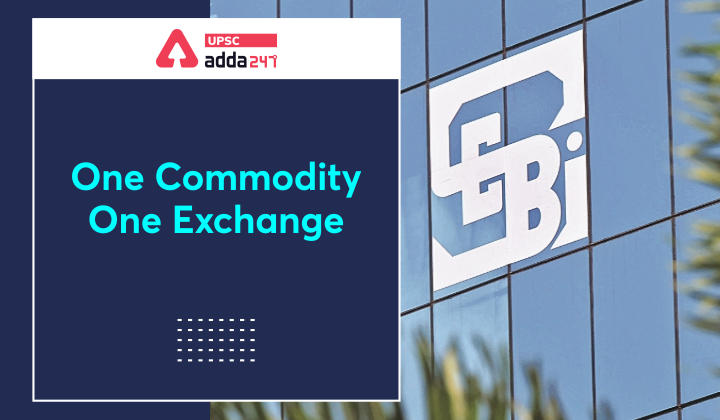Table of Contents
‘One Commodity One Exchange’ Policy: Relevance
- GS 3: Indian Economy and issues relating to planning, mobilization, of resources, growth, development and employment.
‘One Commodity One Exchange’ Policy: Context
- Securities and Exchange Board of India (SEBI) has recently proposed a ‘one commodity one exchange’ policy to reduce fragmentation of liquidity and help every stock exchange develop an exclusive set of un-fragmented liquid contracts.
‘One Commodity One Exchange’ Policy: Key points
- In a consultation paper, SEBI said that it has prepared a concept note on developing exchange specific unique set of commodities for trading in commodity derivatives segment and reducing fragmentation in commodity derivatives markets.
- It has proposed that the concept should only be applicable for narrow agri-commodities.
- The regulator proposed that derivative contracts on new commodities would be traded only on a single stock exchange for a period of 3-5 years during which the exchange would be allowed to launch all kind of permissible products — futures, futures on options and options on goods, among others.
Agri commodities
- SEBI has also advocated that it may not be appropriate to segregate non-agri commodities into ‘narrow’ and ‘broad’ for the purpose of adopting the ‘One Commodity One Exchange’ policy, as in the case of agri commodities, based on annual physical market size.
- The regulator has suggested that the ‘One Commodity One Exchange’ should not be allowed in those non-agricultural commodities where India is not a major producer.
- The agricultural commodities have been classified into three categories — sensitive, broad and narrow.
Exclusivity status
- The ‘exclusivity’ status of a commodity will last for a period of around of 3-5 years from the date of Sebi’s approval.
- However, the exchange can discontinue the exclusivity status before this period.
- The exchange has to take a call on whether they want to remove the exclusivity from the product only after it becomes continuously liquid for 12 months.
‘One Commodity One Exchange’ Policy: Objectives
- The main objectives of developing the concept is to help every exchange to develop an exclusive set of un-fragmented liquid contracts on specific commodities.
- Moreover, the concept will ensure that the concerned exchange develops all kinds of derivative contracts on a specific commodity exclusively and bring about comprehensive development and deepening of the Indian commodity derivatives markets.
- The concept will eventually help India to be in a position so as to be able to influence the global benchmark pricing of such commodities.
- A single exchange launching contracts on a specific commodity may have bigger impact locally as well as internationally. This may be more efficient and low cost in the long run.
Also Read:





 TSPSC Group 1 Question Paper 2024, Downl...
TSPSC Group 1 Question Paper 2024, Downl...
 TSPSC Group 1 Answer key 2024 Out, Downl...
TSPSC Group 1 Answer key 2024 Out, Downl...
 UPSC Prelims 2024 Question Paper, Downlo...
UPSC Prelims 2024 Question Paper, Downlo...
